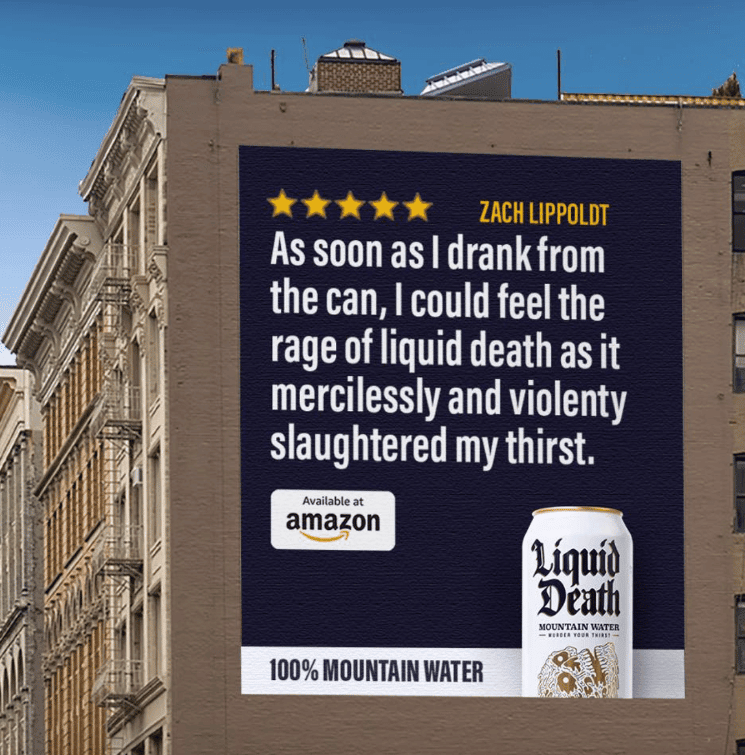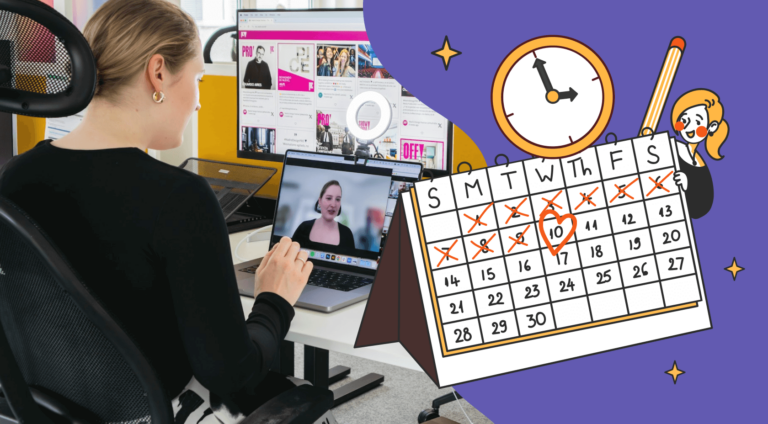Yes, there are certain rules that are meant to be broken, and by doing so, you can stumble onto truly creative solutions that can amaze people (and even get an award for!). But there are some rules that really should be followed rigorously, and by failing to do so, you set up yourself for failure.
In short, the most common customer acquisition mistakes are:
- Lack of niche,
- Vague communication,
- Wrong communication channels,
- Neglecting conversion,
- Making purchases difficult.
1. Trying to Please Everyone
Becoming a household name is a dream come true for many marketers. And if the name of our brand becomes a verb on its own — just like “google it” did — we could all die happily.
Unfortunately, such a scenario is possible only to the select few. While it’s good to be ambitious, it’s just as important to be realistic about what’s actually possible. For example, in the Startup scene, achieving a Unicorn status is the ultimate goal of many, but in reality, there’s only a .00006% chance of success. Betting everything you have on that chance is delusional at best.
Even keeping the business afloat can be a challenge. As claimed by the U.S. Bureau of Labor Statistics, 20% of new businesses fail during the first two years of their existence, 45% won’t survive the next five years, and 65% won’t meet the 10-year mark (source). In the case of Startups, the reality is even harsher, with an astounding failure rate of 90%.
The reasons for failure can vary, from high inflation spikes and a sudden pandemic outbreak, to running out of funds and stakeholders pulling out. But sometimes the reasons aren’t as dramatic and neither are they external — sometimes the issue lies in what you’re selling.
If you’re trying to compete with the biggest brands, you’ll fail before you’ve even started. There’s no point in trying to beat Adidas or become a worthy competitor for Nutella. Not only are these brands so established that they can’t be budged, but they also have big enough funds to survive any hardships or even lawsuits. These spots, which are appealing to the masses, are already taken.
“Fine, if I can’t take Nutella’s spot, I’ll take the one next to it!”, someone might think. Unfortunately, even that is out of reach for money, because most probably, you’ll need several million euros for that honor.
That’s why it’s crucial for your offer to be made to a much narrower audience that has special needs or requirements. In other words, you need to find a niche with a big enough group of people who can’t find what they want on the mainstream market. Let’s see some examples.
Lefty’s is a store that recognized a very neglected group of people: the left-handed ones. More often than not, they have to settle for using items designed for right-handed people, because most stores perceive catering to their special needs as a waste of time and resources. Thankfully, Lefty’s saw that as a great opportunity — we can make products for all these neglected people!
And not only does Lefty’s offer an amazing selection of everyday items — from office supplies to kitchen utensils — it also went the extra mile to make it fun and to make left-handed people feel special (instead of accusing them of being in cohorts with the devil) by showcasing famous left-handed people and introducing merchandise with puns.
If Lefty’s would have tried to compete against the biggest brands that offer office supplies, it might have found itself in trouble. But by answering the needs of a neglected group, it stood out from the crowd and made a pretty big name for itself.
2. Tofu-Level of Bland Communication
There’s another lesson that needs to be learned from Lefty’s strategy — concise, clear communication is the key. Its name is simple yet powerful, because it hints at what the brand is all about.
Because everywhere everything is happening all at once, it’s hard to get your message through all the noise. But you definitely lower your chances of getting noticed with a brand name that’s hard to spell and/or pronounce, or is overly long. So if you have to explain what your brand name means or how to spell it, you might be in trouble.
It also applies to logos. If your logo literally shows what your brand offers, you can expect much better performance (as well as sales), as proved by the study published in the Journal of Marketing Research.
But that’s only half of our job work done. If you’re catching people’s attention and they don’t have to think twice about who you are, you’re at the point where conversion is needed. This is the hardest part.
Conversion requires compelling arguments from you on why people should buy what you offer. You need to present strong benefits and reasons why you’re better than your competitors. If you combine it with the proper tone of voice (suited to your audience — you need to know when to leave memes behind), unique headlines (like Hinge, The dating app designed to be deleted™), and eye-catching ads, you’ll improve your chances of succeeding.
If you do the exact opposite and choose a “safe” communication — that is bland and forgettable — you’ll keep using overused phrases that no longer mean anything (“We’re the best agency that delivers cutting-edge results”). Your potential customers will lose interest and only engage if they have no other choice.
Taking a stand on social or political issues is also a good way to gain visibility, especially since 66% of people deem such information as important. In the times of conscious consumerism, taking a stand against plastic pollution, respecting Human Rights, or rejecting animal testing can endear people to your brand — as long as you stay honest and authentic.
If you don’t think being environmentally-friendly is “cool enough”, look at Liquid Death. Under this ominous name hides a very simple product — water. Instead of selling it in plastic bottles, Liquid Death chose aluminum cans that are easier to recycle, and they’ve also pledged to donate part of their profits to help fight plastic pollution. This worthy cause, along with unique communication that’s both aggressive and fun, earned Liquid Death a strong following.
Currently, this company is worth $700 million.

3. Our Target Audience is in Another Castle!
Maybe you’ve niched down. Maybe your communication is striking, memorable, or even thought-provoking. But if you’re sharing your vision in the wrong place, all your efforts might be for nought.
Nowadays, there are so many customer acquisition channels to choose for your marketing efforts. There’s TikTok, full of viral, yet nonsensical or even absurd videos, the still-kicking Facebook that’s slowly being overtaken by the older generations, or tech-savvy Twitter with an uncertain future. There’s also the paid advertising, from Google Ads to remarketing strategies, that people keep swearing by as a remedy to all marketing pains. Last but not least, there are also the more traditional advertising channels — billboards and other forms of out-of-home advertising that never really went out of fashion.
And that’s just the tip of the iceberg. How to decide what to invest in?
Unfortunately, many marketers decide to follow their guts. Sometimes, they’ll simply pick what they like best (and for example, reject TikTok because it’s “immature”) or what’s the most popular. Or they’ll try to conquer every single channel, burning all the money as they go.
As you can probably tell, this isn’t the best way. Rather, what you need is to make an informed decision based on facts and numbers.
First of all, you need to get to know your target audience. Starting from basic information — age, sex, demographic, geolocalization — and ending with their personal values and beliefs, fears, and needs. You need to understand what makes people interested in your offer in the first place, as well as why they accept or reject it. That’s why proper feedback is priceless, even if it’s a bad one. Reaching out to your audience through polls, surveys, or even calls, is the best possible way to ensure you’re on the same page. You don’t have to guess anything — simply ask.
Once you gather all that information, you’ll be able to say where your target audience likes to spend their time and what kind of content they’re looking for. Maybe they’re looking for easy to swallow knowledge pills on how to run a small business (considering how little time they have), or long, educational videos concerning bunny-proofing your home. Either way, once you get the show running, you’ll gather even more data on views and engagement and be able to adjust your strategy for the best results. But there’s still lots of guessing involved.
Because of how digitized our lives are, we tend to forget the most obvious of solutions. The previously mentioned Oatly thankfully didn’t.
Oatly offers an oat-made alternative to dairy products. It may seem like a nice enough niche, but it’s actually hard to nail down the group of people that are fans. After all, hardly anyone chooses “oak milk” when prompted by Facebook to pick their interests, nor do people visit vegan milk-related websites in their free time. It gets easier though once we abandon the digital world and try to find a place where oat milk is a necessity — such as coffee shops!
By promoting themselves in places that are visited daily by huge numbers of clients, who show interest in coffee and therefore, milk, Oatly made a huge success once the word spread. It wouldn’t have been possible without asking the fundamental question — where my people at?

4. Did You Forget to Convert?
Great news! Your message got across, everyone knows who you are, and the number of visitors on your website keeps growing super fast. But there’s one thing that you might have noticed — while many potential new customers show clear interest, they don’t go further than that. In marketing terms, they’re not converting.
So many marketers focus on brand awareness in their acquisition strategies that they forget to give that extra push to help people decide. How to do that? Well, let’s think first about why people don’t immediately make a purchase and what we can do about it.
- They’re just browsing. Maybe they clicked on your website by mistake or just want to know who you are in the first place. Tough luck getting them to make a purchase — but you can interest them in your newsletter, webinar, or resources. This will keep them engaged with your brand. And if they ever find themselves in need of a specific product or a service, they’ll think of you.
- They want to compare you to your competition first. They’re considering all their available options to make the best decision for themselves. You can make it easier for them by including comparison tables or even whole landing pages that explain why you’re the best person for the job.
- They lack knowledge. Although they’re interested in what you have, they’re unsure of how to use your product properly, how to set it up, or whether it will fit with what they already have. For example, they’d like to buy an eBook reader, but don’t know if their eBooks could be uploaded there. In this case, what you need is educational and informational content in the form of tutorials and guides.
- They have some doubts. They’re not sure that you’re the true professional you’re claiming to be. The fault might lie in your copy — you need to make strong arguments in your favor and emphasize what value your products or services bring. Avoid cliches and empty promises, and focus on case studies, customer success stories, and testimonials.
- They’re not sure it’s for them. Don’t be afraid to call out your target audience. If your SaaS is built for photographers, state it clearly. If your products are made with gamers in mind, make the whole website about them. Don’t be afraid of going too narrow; the risks are fewer than going too wide.
- Your response time is abysmal. If your potential clients reach out to you, either through email, chatbox, social media, or any other form, and you take too long to reply, they can feel discouraged. After all, that’s their first impression of the customer experience that you offer.
- They lack incentive. They want what you offer, but they’re struggling to commit. If you offer a time-sensitive deal or a holiday sale, people might think they won’t get a better deal any time soon and make a purchase.
- They don’t have the money. They want what you offer, but they don’t have the funds. Yet. You shouldn’t cross them off, because sooner or later, they might turn into paying customers — so keep them engaged and don’t let them forget about you any time soon.
If you don’t know how to tell if your conversion is doing well, you need to calculate the conversion rate, which is simply the number of conversions divided by the total number of visitors during a specific time period. If the result falls between 2% and 5%, you’re actually doing pretty good. If it’s less than that, you need to up your game.
If you’d like to learn more about fundamental metrics, such as customer acquisition cost formula, customer retention rate, customer lifetime value, and other customer acquisition costs, read this article.
5. Playing Hard to Get
So far, we did everything right. People are aware of our brand, they show clear interest, and they want to buy our products or services. Nothing can go wrong now, right?
Wrong.
If your customer experience isn’t up to par, people might change their mind quickly enough. What to look out for?
Slow website
If your website is painful to navigate because of how slow it loads, people will feel discouraged and leave. Remember that today, everyone is impatient — we’re spoiled so much by how fast technology works, that any sign of delay can lead to frustration. We want everything and we want it now.
And not only is it crucial to ensure your website performs well on desktop, but also on mobile devices. People keep spending more and more time on their phones each year (not counting talking), and as of April 2021, the average was 4 hours and 23 minutes. This means there’s a pretty big chance someone will visit your website while scrolling on their phone, so be prepared for that and deliver a fast and smooth experience.
To see how your website performs, you can simply check on it from different devices and browsers, or better yet, use Google’s Core Web Vitals.
Bad UX/UI
If your website is performing well, but the design leaves much to be desired, potential clients will deem you unprofessional. Even worse, bad design can leave them confused and unsure of what to do next, especially when you include flashy animations that hide navigation (only creative agencies can get away with that). While keeping things simple may not seem that exciting, at least no one will complain about feeling lost.
You also need to keep track of your links and make sure that none are broken. While a broken link in an article isn’t catastrophic, a broken link to your pricing page very well could be.
The most crucial information needs to be clearly displayed and easy to access. Pricing, Contact Forms, as well as the About Us page should be visible at all times, no matter the subpage. Proper website architecture isn’t only beneficial to users, but it also influences SEO.
Too Many Steps
UX/UI Design isn’t only about looking pretty. It’s mostly about helping users achieve their goals. If, for example, someone is looking for visa requirements to another country and they can’t find it on your website, they’re forced to check that elsewhere.
But you can also, purposely or not, make certain actions more difficult. Contact forms are a great example — some websites require providing a lot of personal information, from phone number to the size of your company and your role in it. The more you ask for, the fewer people will convert.
Another example is signing up for a trial. If you require credit card information from users, they’ll be more likely to leave the page. On the other hand, there’s a higher chance that those who sign up will be more valuable customers in the long run.
Mistake-Free Customer Acquisition Strategy
There are five things you need to take into consideration when creating your customer acquisition process:
- Having a niche. If you try to sell to everyone, you’ll be competing with the biggest business shark, who’ll chomp on you on so many fronts.
- Having a clear communication. Your clients want to quickly understand what you’re about, what benefits come from trusting you, and even what your beliefs are. If you go for a safe and proper communication, you’ll come across as bland and completely forgettable.
- Having the right communication channels. You need to know who your target audience is and where they’re spending their time the most. Then focus on one or two channels and see what kind of content engages your audience the most.
- Neglecting conversion. Don’t forget that brand awareness isn’t the end goal. While high numbers of followers and visitors is certainly impressive, it leads to nowhere when it doesn’t turn into profits.
- Making it difficult. Make it as simple as possible for your clients to learn all they need and make a purchase. This includes good website performance across all devices as well as best UX/UI design practices.
Now that you’ve learned all about the most common customer acquisition mistakes, you can create or improve your marketing strategy that will result in better sales overall. But before you go, remember that in the end, what matters is your product or a service — if it doesn’t solve any problems or make lives easier, even the best tips and tricks won’t save you from disaster. So make sure that all your basics are strong!

A free online training. Delivered daily to your inbox to grow your productized agency.












